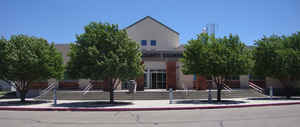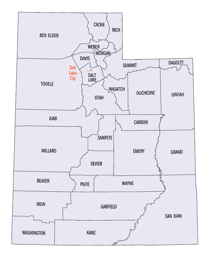Utah Counties
There are twenty-nine counties in the State of Utah. There were originally seven counties established under the provisional State of Deseret in 1849: Davis, Iron, Sanpete, Salt Lake, Tooele, Utah, and Weber. The Territory of Utah was created in 1851 with the first territorial legislature meeting from 1851-1852. The first legislature re-created the original counties from the State of Deseret under territorial law as well as establishing three additional counties: Juab, Millard, and Washington. All other counties were established between 1854 and 1894 by the Utah Territorial Legislature under territorial law except for the last two counties formed, Daggett and Duchesne.Wasatch County, Utah
Wasatch County Education, Geography, and History

Wasatch County is a county located in the state of Utah. Based on the 2010 census, the population was 23,530. Its county seat and largest
city is Heber City. The county was named for a Ute Indian word meaning mountain pass or low place in the high mountains.
Wasatch County is part of the Heber, UT Micropolitan Statistical Area as well as the Salt Lake City-Provo-Orem, UT Combined Statistical Area.
Etymology - Origin of Wasatch County Name
from the Wasatch Mountains
Demographics:
County QuickFacts: CensusBureau Quick Facts
Wasatch County History
Heber Valley, one of several back
valleys in the Wasatch Mountains, is often called Utah's Switzerland because of
the rugged beauty of Mount Timpanogos located to the west, its climate, and a
large population of Swiss that settled in Midway. Its highest peaks top 10,000
feet, and over half the land is 7,500 feet above sea level. The climate,
classified as undifferentiated highlands, offers cool summers and very cold
winters. The average annual precipitation is about 16 inches.
The county is divided into two watersheds--the Colorado and the Great Basin
drainage systems. Because of its annual precipitation and its location between
the Uinta and Wasatch mountains, Heber Valley is well endowed with water.
Flowing from the East are Daniels, Lake Fork, and Center creeks. From the north
and northeast is the Provo River. From the west Snake Creek drains a central
portion of the Wasatch Mountains. Two additional sources of water are man-made;
the Ontario Drain Tunnel west of Keetley drains many of the Park City mines, and
the Weber/Provo diversion canal diverts water from the Weber across the Kamas
prairie in Summit to the Provo River in Wasatch County.
Prior to the 1850s Heber Valley was an important summer hunting ground for the
Timpanogos Utes living around Utah Lake. The first white men to visit the county
were members of the Dominguez-Escalante expedition in 1776. They skirted Heber
Valley, traveling down Diamond Fork to Spanish Fork Canyon and then into Utah
Valley. Fifty years later fur trappers entered the county.
In 1824 and 1825 Etienne Provost from Taos, New Mexico, trapped beaver in the
Uinta and Wasatch mountains. About that time William H. Ashley and members of
his fur company from St. Louis also hunted and trapped for beaver in the county.
The first settlers came into Wasatch County from Utah Valley in the spring of
1859 and located a short distance north of present Heber City. That same year
Midway and Charleston were also settled. In 1862 the territorial legislature
created Wasatch County which then included all of the Uinta Basin. Wasatch in
Ute means "mountain pass" or "low pass over high range". Heber City, named for
Mormon Apostle Heber C. Kimball, was selected as the county seat. The last
boundary change occurred in 1914 when Duchesne County was created out of the
eastern half of Wasatch County. The county produces hay, dairy products, sheep,
and cattle.
During the early 1900s, after the Denver and Rio Grande Railroad completed a
line into the county from Provo, Heber City became an important shipping
terminal for wool and sheep. In 1922 the Union Pacific Railroad constructed a
spur from Park City to the mines west of Keetley and began shipping lead, zinc,
and silver ore. Today neither railroad line is in full operation, and other
economic activities are more important to the county than transportation and
mining.
Strawberry Reservoir (completed in the 1910s), Deer Creek Reservoir (completed
in the 1940s), and Jordanelle Reservoir (under construction in the 1980s),
together with sparkling streams and beautiful mountain scenery, have made
Wasatch a popular recreation area. The county provides excellent economic
activities are more important to the county than transportation and mining.
*Sources: Beehive History 14: Utah Counties. 1988. Utah State Historical Society, 300 Rio Grande, Salt Lake City, UT 84101-1182.
Geography: Land and Water
As reported by the Census Bureau, the county has a total area of 1,209 square miles (3,132 km2), of which,
1,177 square miles (3,049 km2) of it is land and 32 square miles (82 km2) of it (2.63%) is water.
Neighboring Counties
Bordering counties are as follows:
- Salt Lake County, Utah - (northwest)
- Summit County, Utah - (north)
- Utah County, Utah - (west)
- Duchesne County, Utah - (east)
Education







